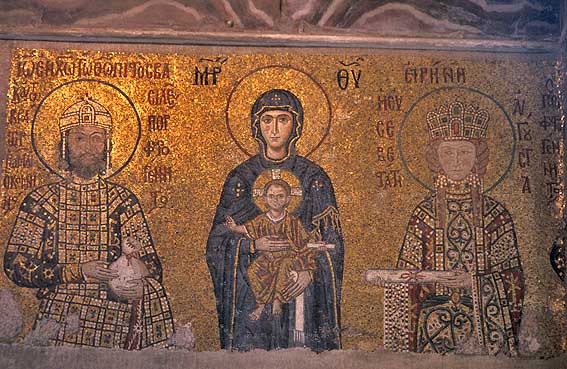Etkinlikler
EXCURSION THROUGH HISTORIC PENINSULA
18 October 2008, Saturday

(for bigger map pls click here)
08:45 Meeting in front of the
Conference Hall (Taskisla Campus)
09:15 Hagia Sofia
10:15 Yerebatan Cistern
11:15 Sultanahmet Mosque
12:00 Lunch
13:15 Topkapı Palace
16:00 Return back to Taskila Campus
HAGIA SOPIA

The current building was originally constructed as a church between A.D. 532 and 537 on the orders of the Byzantine Emperor Justinian, and was in fact the third Church of the Holy Wisdom to occupy the site (the previous two had both been destroyed by riots). It was designed by two architects, Isidore of Miletus and Anthemius of Tralles. The Church contained a large collection of holy relics and featured, among other things, a 50 foot (15 m) silver iconostasis. It was the patriarchal church of the Patriarch of Constantinople and the religious focal point of the Eastern Orthodox Church for nearly 1000 years.
In 1453, Constantinople was conquered by the Ottoman Turks and Sultan Mehmed II ordered the building to be converted into the Ayasofya Mosque[1]. The bells, altar, iconostasis, and sacrificial vessels were removed, and many of the mosaics were eventually plastered over. The Islamic features - such as the mihrab, the minbar, and the four minarets outside - were added over the course of its history under the Ottomans. It remained as a mosque until 1935, when it was converted into a museum by the Republic of Turkey.
http://en.wikipedia.org/wiki/Hagia_Sophia
YEREBATAN CISTERN

One of the magnificent historical constructions of Istanbul is the Basilica Cistern, located near south-west of Ayasofya (Hagia Sophia). This huge cistern, which was founded by Justinianus I, a Byzantine Empire (527-565), began to be called by the public ‘the Sinking Palace‘ - and not without a reason, seeing the great number of marble columns arising out of the water. In place of the cistern was formerly found a great Basilica, which had probably been built in IIIrd or IVth century during the Early Roman Age to be used in commercial and legal affairs and scientific and artistic activities. The basilica was reconstructed by Ilius after it had burned down in a conflagration that broke out in 476. Then it suffered another conflagration. It had a marble statue during the calamitous Nika rebellion in 532 which terrorized the city.
It is narrated in former references that there was a garden here, surrounded by a colonnade, which faced Ayasofya. It is also added that there was a bronze statue of the Prophet Solomon in the garden, with his hand on his chin looking in amazement at Ayasofya, which was even more marvellous than his work. The mentioned statue was later removed by the Emperor Basilius I (867-886). As is known, the temple that been erected by the Israeli King, the Prophet, Solomon in Jerusalem in his name had been known as the most magnificent work on earth until Ayasofya was constructed. It is further narrated that the Emperor Basilius had the said statue melted and had his statue erected on the spot. The Emperor Justinianus had this cistern built in 542 on the site of the great basilica that had been destroyed in a conflagration.
www.yerebatan.com/english/index.html
SULTANAHMET CAMİİ

The Sultan Ahmed Mosque (Turkish: Sultanahmet Camii) is a historical mosque in Istanbul, the largest city in Turkey and the capital of the Ottoman Empire (from 1453 to 1923). The mosque is one of several mosques known as the Blue Mosque for the blue tiles adorning the walls of its interior. It was built between 1609 and 1616, during the rule of Ahmed I. Like many other mosques, it also comprises a tomb of the founder, a madrasah and a hospice. The Sultan Ahmed Mosque has become one of the greatest tourist attractions of Istanbul.
http://en.wikipedia.org/wiki/Sultan_Ahmed_Mosque_(Istanbul)
TOPKAPI PALACE

Topkapı Palace constructed by Fatih Sultan Mehmet, (the Conqueror) in 1478 has been the official residence of the Otoman Sultans and center of State Administration around 380 years until the construction of Dolmabahçe Palace by Sultan Abdülmecid. The palace having around 700.000 m.² area during the foundation years has currently 80.000 m.² area.
Topkapı Palace was evacuated by the accommodation of the Palace inhabitants in Dolmabahçe, Yıldız and in other palaces. Upon abandoning by the Sultans, Topkapı Palace where many officials resided had also never lost its importance. The palace was repaired from time to time. A special attention was taken for the annual maintenance of Mukaddes Emanetler Dairesi (Sacred Safekeeping Rooms) visited by the sultan and his family during Ramadan.
The opening of Topkapı Palace for visits as museum happened firstly in the reign of Sultan Abdülmecid (1839-1861). The belongings within Topkapı Palace Treasury was shown to the contemporary English ambassador. Later on, it has become a tradition to show the antics within the Topkapı Palace Treasury to the foreigners and during the era of Sultan Abdulaziz (1861-1876), showrooms are made in French style, and these antics are started to be shown to foreigners in these showrooms within Treasury. During the period when Sultan II Abdulhamid was dethroned (1876-1909), it was thought to open the Treasury Room to public visits on Sundays and Tuesdays, yet it never realized.
By the order of Ghazi Mustafa Kemal Atatürk, Topkapı Palace firstly affiliated to the Istanbul Asar-ı Atika Museums Directorate and opened to public visits on date of April 3, 1924, then it started to service as Treasury Chamberlain, after it was renamed as Treasury Directorate and finally it was renamed as Topkapı Palace Museum Directorate and it still continues its services.
Upon the performance of small repairs and taking some administrative cautions in 1924, Topkapı Palace was opened to service as a Museum on October 9, 1924. The sections opened to visit at that time were Kubbealtı, Arz Odası, Mecidiye Köşkü (Pavilion Mecidiye), Hekimbaşı Odası (Room of Chief Doctor), Mustafa Paşa Köşkü (Pavilion Mustafa Pasha) ve Bağdad Köşkü‘dür (Pavilion Baghdad).
http://www.topkapisarayi.gov.tr/eng/tarihce.html

